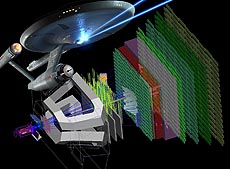What's the deal with antimatter?
 |
| Antimatter can be found in science fiction and in fact. It both powers fictional starships and is associated with one of the most perplexing mysteries in modern physics. Since our theories suggest that matter and antimatter should have been made in equal quantities, yet we observe only matter, this mystery is really quite fundamental: Why are we here at all? |
Read the expanded column on antimatter. View a video on antimatter.
Star Trek taught us that if we want to go blasting all over the galaxy, we need to harness the power of antimatter. Of course it also taught us about dilithium crystals, Vulcan neck pinches and Klingon blood wine. Is there any reason to think that antimatter is any less fictional than these other outlandish ideas?
In 1928, Paul Dirac predicted the existence of antimatter when he successfully merged Einstein's theory of special relativity with quantum mechanics. His equations had two solutions. One explained ordinary matter while the other solution was the negative of the first. After people proposed a few ideas as to what the second solution meant, the situation became greatly clarified in 1932 with Carl Anderson's discovery of antimatter high in the Colorado Rockies.
Antimatter is actually not much different from ordinary matter. There are antiquarks, antileptons, antiprotons, antineutrons and antielectrons. If we had a bunch of these antiparticles, we could make anti-atoms and indeed an entire anti-universe.
Things get trickier when ordinary matter and antimatter are placed in contact with one another. When they are, they annihilate each other, resulting in a huge amount of energy. Something with the mass of a paper clip touching an identical amount of antimatter would release the same amount of energy as the first atomic explosion at the Trinity site in New Mexico. It could also produce enough energy to lift a space shuttle to orbit 20 times. The plot device in Dan Brown's Angels and Demons is physically possible.
Physically possible, perhaps, but practically impossible. Fermilab's antiproton source made more antimatter over its quarter-century of operations than any other facility. Yet if you took all of the antimatter ever made and combined it with matter, the energy release would warm about 5 gallons of coffee from room temperature to something drinkable. Making antimatter is really hard. If you take a tremendous amount of energy, you can make matter and antimatter in equal (minuscule) quantities.
If antimatter and matter are made in equal quantities, then we have a problem. In the early universe, the cosmos was filled with energy. As the universe expanded and cooled, the energy converted into identical amounts of matter and antimatter, and yet the universe we inhabit appears to be made entirely of matter. So where did all the antimatter go?
This is a good question, and we don't have a good explanation yet. It appears that very early in the history of the universe, just a fraction of a second after it began, an unknown mechanism caused a very, very small imbalance. For every 1,000,000,000 antimatter particles, there were 1,000,000,001 matter ones. The billion matter and antimatter particles annihilated, leaving the tiny trace of leftover matter from which our cosmos was built. Several measurements at the Tevatron and the LHC have investigated this question and will continue to study the matter in detail. It is fair to say that the antimatter asymmetry is one of the central questions of particle physics today.
—Don Lincoln
Want a phrase defined? Have a question? E-mail today@fnal.gov.
|